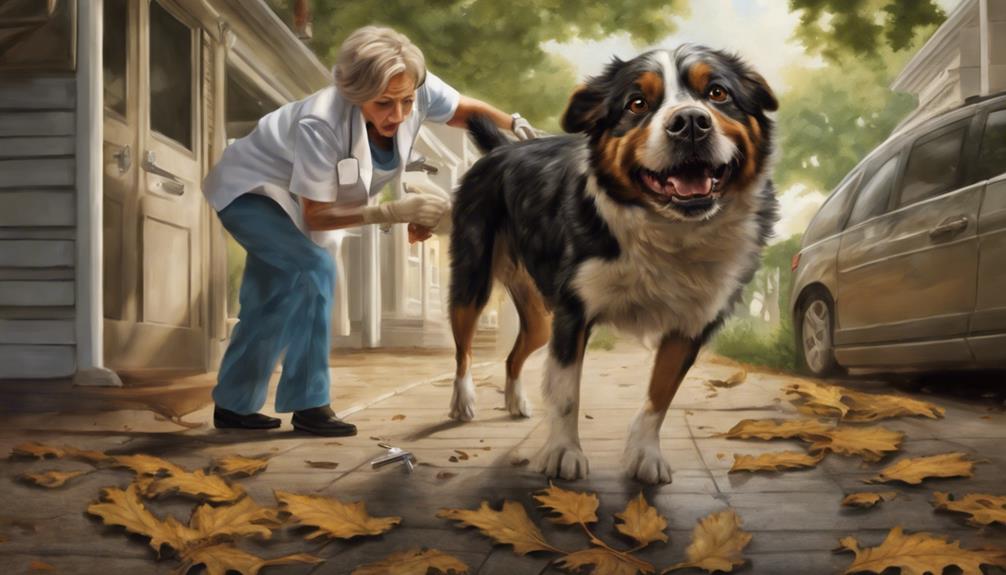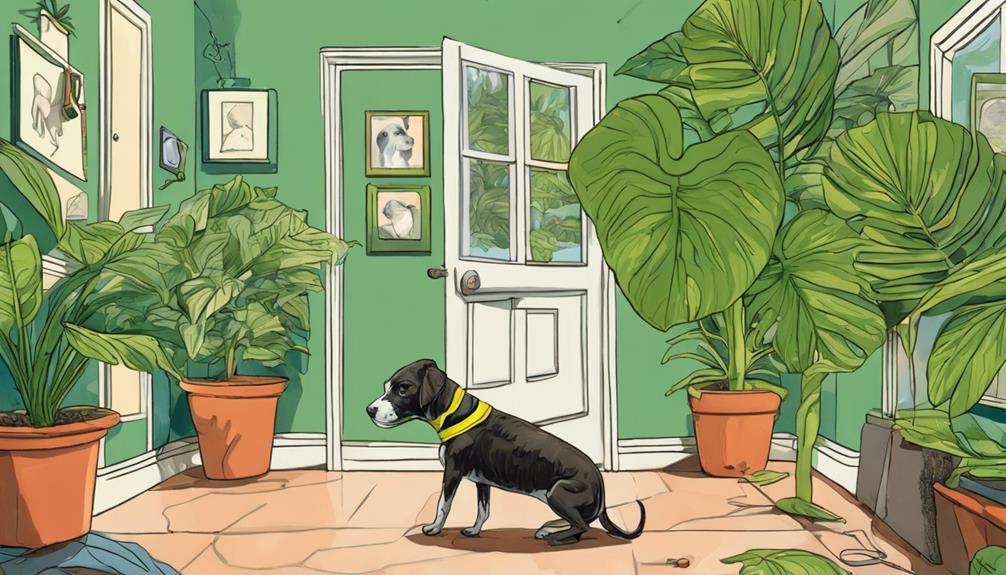Oak leaves pose dangers for dogs due to tannic acid causing stomach issues, skin problems, and poisoning risks. Symptoms include vomiting, diarrhea, and organ damage, needing swift vet help. Treatments include inducing vomiting, fluids, and vet visits. Prevent issues with supervision, training, and yard maintenance. Timely vet care is essential post-exposure, watching for signs, addressing skin troubles, and seeking help for any illnesses. Understanding these risks and acting promptly is key to keeping dogs safe around oak leaves.
Key Takeaways
- Oak leaves contain tannic acid causing gastrointestinal upset.
- Contact can lead to skin irritation and reactions.
- Ingestion or skin contact can result in oak poisoning.
- Symptoms include vomiting, diarrhea, and organ damage.
- Prompt veterinary care is crucial for treatment and recovery.
Harmful Effects of Oak Leaves on Dogs
We've observed that oak leaves pose significant risks to dogs, primarily due to the presence of tannic acid, which can trigger gastrointestinal issues and skin reactions in these animals. If dogs eat oak leaves, they may experience gastrointestinal upset, leading to symptoms such as vomiting, diarrhea, and abdominal pain.
Additionally, contact with oak leaves can result in skin irritation, itching, and hives in dogs. It's essential to recognize that oak leaves are harmful to dogs and can cause oak poisoning if ingested or in contact with the skin. If you suspect your dog has been exposed to oak leaves or is showing symptoms of toxicity, it's vital to contact your veterinarian immediately for proper guidance and treatment.
Symptoms of Oak Leaf Poisoning

After acknowledging the harmful effects of oak leaves on dogs, it's important to be aware of the symptoms of oak leaf poisoning that can manifest in these animals. When a dog ingests oak leaves, several symptoms may indicate poisoning:
- Gastrointestinal Upset: Dogs may experience vomiting, diarrhea, and abdominal pain as a result of ingesting oak leaves.
- Organ Damage: Tannic acid present in oak leaves can harm a dog's kidneys and liver, potentially leading to severe organ damage.
- Respiratory Distress: In severe cases of oak leaf ingestion, dogs may struggle with breathing and exhibit signs of respiratory distress.
Recognizing these symptoms early on is vital in ensuring prompt treatment and care for dogs that have ingested oak leaves. If you notice any of these signs in your pet after they've come into contact with oak leaves, it's recommended to seek veterinary assistance immediately to prevent further harm.
Treatment Options for Oak Leaf Ingestion in Dogs

Treatment options for oak leaf ingestion in dogs typically involve inducing vomiting to expel the leaves from the stomach. This helps remove any remaining leaves and reduce the risk of further toxin absorption.
Providing essential care, such as fluids and monitoring essential signs, is pivotal for the dog's recovery. If the ingestion is severe, administering activated charcoal can help prevent additional toxin absorption.
It's imperative to closely monitor the dog for any worsening symptoms or complications following oak leaf ingestion. Follow-up visits with a veterinarian may be necessary to guarantee the dog's complete recovery and well-being.
Preventing Oak Leaf Toxicity in Dogs

To prevent oak leaf toxicity in dogs, regular yard maintenance, including cleaning up fallen leaves, is essential. Here are some tips to help you keep your furry friends safe:
- Supervision: Keep a close eye on your dog while they're outside to prevent them from ingesting oak leaves.
- Training: Teach your dog commands like 'leave it' or 'drop it' to discourage them from eating potentially harmful leaves.
- Awareness: Be familiar with the signs of oak leaf poisoning in dogs, such as vomiting, diarrhea, lethargy, and loss of appetite, so you can act promptly if you notice any clinical signs.
Importance of Prompt Veterinary Care for Oak Leaf Ingestion

Seeking prompt veterinary care for dogs that have ingested oak leaves is essential to monitor and address any potential symptoms that may arise. After ingestion, it's important to observe for signs such as vomiting, weakness, or changes in behavior. If your dog experiences persistent vomiting, lethargy, or abnormal clinginess, immediate veterinary attention is necessary.
Skin irritation from oak leaf ingestion can be managed by applying Hydrocortisone/Benadryl ointment and Neosporin, while using an e-collar can prevent further licking and aid in the healing process. If the dog shows any signs of systemic illness or if the skin rash worsens, don't hesitate to seek prompt veterinary care.
Monitoring your dog closely and being proactive in getting veterinary attention can make a significant difference in their recovery and overall well-being after ingesting oak leaves or acorns.
Frequently Asked Questions
Are Oak Leaves Toxic to Dogs?
Yes, oak leaves are toxic to dogs. Ingesting them can lead to gastrointestinal upset, kidney, and liver damage. Symptoms vary depending on the amount ingested and the dog's size.
It's important to monitor dogs closely for distress after they eat oak leaves. Keep dogs away from oak trees to prevent poisoning.
If you suspect your dog has ingested oak leaves, contact a veterinarian immediately for guidance and assistance.
Are Oak Leaves Poisonous?
Oak leaves are toxic to dogs due to the presence of tannic acid. Consuming these leaves can lead to gastrointestinal upset, vomiting, and other symptoms. The seriousness of poisoning varies depending on the quantity ingested and the dog's size and health.
Monitoring for symptoms such as vomiting, weakness, and behavior changes is vital. If distress or symptoms continue after ingestion, immediate veterinary attention is advised to safeguard the dog's well-being.
Can Tree Leaves Be Poisonous to Dogs?
Yes, tree leaves can indeed be harmful to dogs.
It's important to be aware of the potential dangers various types of leaves pose to our furry friends.
Understanding which leaves are toxic can help prevent harmful ingestions and keep our dogs safe.
Being vigilant and proactive in monitoring our pets' interactions with nature can greatly reduce the risks associated with poisonous leaves.
Can Dogs Chew on Oak Tree Branches?
Yes, dogs can chew on oak tree branches, but it's important to prevent them from doing so due to the dangers associated with oak branches.
Chewing or ingesting oak branches can result in gastrointestinal upset, liver and kidney damage, and other serious health issues for dogs.
To keep our furry friends safe, it's best to discourage them from chewing on oak tree branches and seek immediate veterinary attention if they do.
Conclusion
To sum up, oak leaves can present serious risks to dogs if consumed, resulting in symptoms such as vomiting, diarrhea, and lethargy. It's crucial to seek immediate veterinary attention if you suspect your dog has ingested oak leaves to prevent further complications.
Were you aware that oak leaves contain a toxin known as tannic acid, which can lead to kidney damage in dogs if consumed in large amounts?
Stay alert and ensure the safety of your four-legged companion from potential hazards in your environment.










